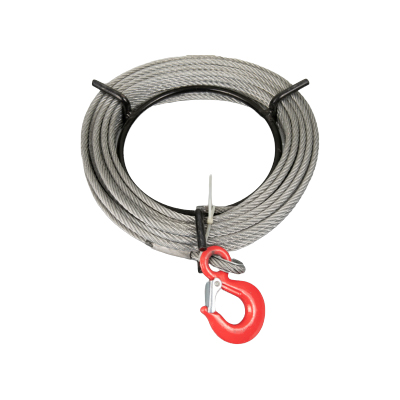Features of Cable Tow with Hooks
2024-06-21
A cable tow with hooks typically refers to a specialized towing or recovery cable equipped with hooks at both ends. These cables are designed for heavy-duty applications where vehicles, equipment, or objects need to be towed, pulled, or lifted. Here’s an overview of cable tow with hooks, its features, applications, and considerations:
Features of Cable Tow with Hooks:
1. Material and Construction:
- High-Strength Cable: Made from durable materials such as steel or synthetic fibers (e.g., nylon or polyester) to withstand high tension and loads.
- Braided or Twisted Construction: Provides strength and flexibility needed for towing and recovery operations.
2. Hooks:
- Heavy-Duty Hooks: Attached securely at both ends of the cable to connect to towing vehicles or anchor points.
- Safety Latches: Some hooks may feature safety latches or clasps to prevent accidental disconnection during use.
3. Length and Capacity:
- Available in various lengths to accommodate different towing distances and operational requirements.
- Capacity ratings typically range from light-duty (e.g., for towing small vehicles) to heavy-duty (e.g., for recovery of large trucks or equipment).
4. Weather Resistance:
- Resistant to corrosion and weather elements to ensure reliability and longevity in outdoor and rugged environments.
- Coated or galvanized cables provide additional protection against rust and abrasion.
Applications of Cable Tow with Hooks:
1. Vehicle Recovery:
- Used by towing companies, off-road enthusiasts, and emergency responders to recover vehicles stuck in mud, snow, or off-road terrain.
- Provides a secure connection for pulling vehicles out of ditches, water, or other challenging conditions.
2. Towing Operations:
- Essential tool for towing disabled or stranded vehicles on roads, highways, and construction sites.
- Enables safe and controlled towing of vehicles to repair shops, service centers, or designated parking areas.
3. Construction and Industrial Use:
- Employed in construction sites and industrial facilities for moving heavy machinery, equipment, or materials.
- Facilitates lifting and positioning of objects during construction, demolition, or installation projects.
4. Off-Road and Recreational Activities:
- Used in off-road vehicles, ATVs, and recreational vehicles (RVs) for self-recovery or assisting others in challenging terrain.
- Enables safe extraction and recovery during outdoor adventures, camping, and trail riding.
Considerations for Cable Tow with Hooks:
1. Safety Precautions:
- Ensure proper training in towing procedures and safety protocols to prevent accidents and injuries during use.
- Regularly inspect cables, hooks, and connections for signs of wear, damage, or degradation.
2. Weight and Capacity:
- Select a cable with sufficient weight capacity to handle the maximum load expected during towing or recovery operations.
- Avoid exceeding the rated capacity to prevent equipment damage or failure.
3. Storage and Maintenance:
- Store cables properly to prevent tangling and ensure quick deployment when needed.
- Clean and lubricate hooks and cables regularly to maintain functionality and prevent rust or corrosion.
4. Legal and Regulatory Compliance:
- Adhere to local laws and regulations governing towing and recovery operations, including proper use of safety equipment and signage.
A cable tow with hooks is a versatile and essential tool in various industries and recreational activities where towing, recovery, and lifting operations are required. Choosing the right cable based on strength, length, and environmental conditions ensures safe and efficient handling of towing tasks.



